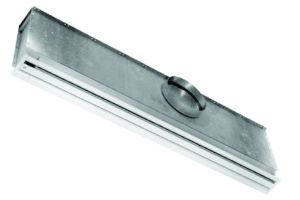 The use of intelligent diffusers allows to modulate the air volume of an air conditioning system, in addition to offering greater efficiency and effectiveness.
The use of intelligent diffusers allows to modulate the air volume of an air conditioning system, in addition to offering greater efficiency and effectiveness.
by Alfredo Sotolongo*
The most economical energy to produce is the one that is saved!
In recent writings I have concentrated on the advantages of affinity laws applied to modulate the volume of the three fluids with which an air conditioning system is controlled: air, water and refrigerant.
Specifically, the equation representing the ratio of horsepower to engine rotation or revolutions per minute applies. Which is represented below:
HP1/HP2 = (RPM1/RPM2)ɜ
Where:
HP1 = Original horsepower.
HP2 = Resulting horsepower.
RPM1 = Original revolutions per minute directly proportional to the original volume.
RPM2 = Reduced revolutions per minute directly proportional to the reduced volume.
Example
An air handling unit with centrifugal fan, which moves an original volume of 5,000 CFM when the engine rotates at 1,800 revolutions per minute, consuming ten horsepower by reducing the volume to 50%, 2,500 CFM, the rotation is lowered by half, 900 revolutions per minute and we get the following result:
When applying the equation: HP1/HP2 = (RPM1/RPM2)ɜ
10/HP2 = (1800/900)ɜ = 2ɜ = 8
Therefore, in theory HP2 = 10/8 = 1.25 horsepower. Lower consumption from 10HP to 1.25 HP.
Note: It is important to note that in the case of air and water, centrifugal fans and water pumps, there may be limitations in the minimum rotation speed since there are resistances such as friction in the bearings. However, whenever the volume and therefore the rotation are reduced, the energy savings are considerable. In the case of variable refrigerant this limitation does not apply and the reduction in rotation of the centrifugal compressor can be greater, this is because there is no additional friction because the bearings are magnetic.
In this writing I want to concentrate on the most efficient and effective air volume control, which is achieved with intelligent diffusers. When variable volume of air is applied, the purpose is to subdivide the conditioned area into as many zones as possible and this is achieved when each diffuser is a control point with its thermostat integrated.
When the thermal load, particularly the sensitive heat, is satisfied in one or more areas, the thermostat of each diffuser modulates the volume of air that each diffuser must distribute to meet the thermal demand at all times. The pressure increases in the ducts as the volume of air is restricted. The pressure control that modulates the variable frequency drive in each air handling unit reduces the revolutions per minute of the engine and therefore the energy consumption of the motor exponentially as it appears in the equation of the laws of affinity.
The smart variable volume diffuser is more effective and economical than variable volume boxes since each diffuser represents a control area. While the boxes to make them economically feasible are used with several diffusers in different areas and the only area where the sensitive load is truly satisfied is where the thermostat is located. The other areas, which do not have thermostats, could be either too cold or too hot and there is no comfort control. Variable volume boxes operate at pressure drops up to four times higher than that of smart diffusers, penalizing the horsepower needed by the air handling unit's fan motor.
Temperature control is optimized in each area of the building as each smart diffuser is an independent zone. Each occupant adjusts the thermostat to meet their comfort condition within a range of 11/2⁰F or 0.9⁰C. It is an essential requirement to maintain the constant supply speed regardless of the volume of air, with this it is achieved that the air maintains the distance to which it must always reach and also, an even distribution of the temperature.
To design an air conditioning system where energy savings are maximized, it is important to modulate the volume of the three fluids that make up the central system: air, water and refrigerant. If it is not possible to modulate all three, at least some of them must be modulated. If what they can modulate is the volume of air, I suggest to our colleagues that they use intelligent diffusers, which in addition to the energy savings they represent, are the lowest initial cost per control area.
If you need more information on any of the topics covered in this column, please contact me at the email [email protected]
* President of Protec, Inc., is certified as a professional engineer in Puerto Rico and the state of Florida; has more than 40 years of experience in the application and sale of systems and equipment for energy conservation. He is a member of ASME (American Society of Mechanical Engineers), AEE (Association of Energy Engineers), ASHRAE and was president of the Miami chapter of that association.













